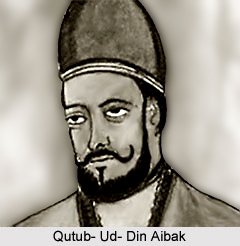The slave (MAMLUK) Dynasty : in 1194 Delhi, Qutbuddin-Aibak destroyed 27 Hindu temples & built the Quwwat-ul-Islam (Qutab Minar) mosque with their ruins


After Ghori was assasinated, Qutbuddin Aibak, his lieutenant, took up the cause and attacked many cities. Aibak is also described by Hasan Nizami as suppressing a Hindu revolt at Kol (Aligarh) in 1193, after which he raised three bastions with the severed heads of the defending infidels, while piles of their carcasses became food for beasts of prey.
He relates that the area was freed from any temples and deities, thus the foundations of the infi dels were destroyed. In Delhi in 1194, Aibak destroyed 27 Hindu temples and built the Quwwat-ul-Islam (Qutab Minar) mosque with their ruins. Aibak decorated
it with the precious stones and gold obtained from the temples which were destroyed by the elephants, as described by Nizami.
The mosque was completed by his former Turkish slave, Iltutmish, who had killed Aibak’s
successor, Aram, in order to take the throne. To defend themselves, the Mher tribe in Ajmer revolted against Aibak, assisted by the Chaulukyas of Gujarat. Aibak had to call for re-enforcements from Ghazni before he could return the attack. Then in 1196 he advanced on Anahilwar Patan, Gujarat’s capital. Nizami records that after Raja Karan was
defeated, 50,000 infidels were “sent to hell” by the sword, and 20,000 slaves, and more cattle than countable were possessed by the victors.
The temples were all demolished and palaces sacked. Back at Ajmer, Aibak destroyed the Sanskrit College of Visaladeva, and then laid the foundation of a mosque, which was later known as the ADhai Din ka Jhopada.
In 1202, Aibak’s conquest of Kalinjar was his greatest achievement, where he converted temples into mosques and took away 50,000 men as slaves, so many that the plains became “black as pitch with Hindus,” as described by Nizami. Aibak claimed himself to be the new Sultan of Delhi when Ghuri was assassinated by the Gakkhars in 1206.
Obviously, after all that fighting and conquering, Muhammad Ghuri was not left with much time to enjoy the spoils. Aibak established what is called the “Slave Dynasty” because he and some of his successors were slaves before they rose to such an elevated position.
However, Aibak’s rule only lasted four years, due to the glory of God, ending when he was killed in a polo accident.
Source : Stephen Knapp – Crimes Against India
DISCLAIMER: The author is solely responsible for the views expressed in this article. The author carries the responsibility for citing and/or licensing of images utilized within the text.
